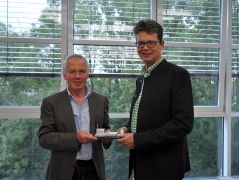MLZ is a cooperation between:
 > Technische Universität München
> Technische Universität München > Helmholtz-Zentrum Hereon
> Helmholtz-Zentrum Hereon
 > Forschungszentrum Jülich
> Forschungszentrum Jülich
MLZ is a member of:
 > LENS
> LENS > ERF-AISBL
> ERF-AISBL
MLZ on social media:

MLZ (eng)
Lichtenbergstr.1
85748 Garching
05.10.2020
Georg Roth honored for his outstanding contributions to MLZ
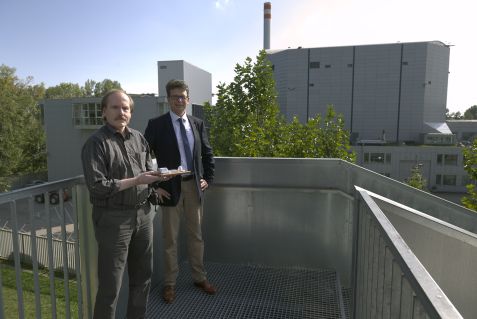
Miniature and original: Prof. Dr. Georg Roth (l.) holds the replica of the FRM II, which he received from MLZ director Prof. Dr. Peter Müller-Buschbaum © W. Schürmann / TUM
The MLZ has honored Prof. Dr. Georg Roth from RWTH Aachen University for his distinguished long-term service to the facility. Prof. Roth’s contributions are recognized with the prize for instrumentation and scientific usage, in particular for his involvements with two diffractometers utilizing hot neutrons, HEiDi and POLI.
The prize, a replica of the Atomic Egg and FRM II made of aluminum, was presented by Prof. Dr. Peter Müller-Buschbaum, Scientific Director of FRM- II and MLZ, during the University Group Leaders Meeting on September 22nd. Prof. Roth retired at the end of July, leaving behind “a big painful gap” said Müller-Buschbaum in his tribute.
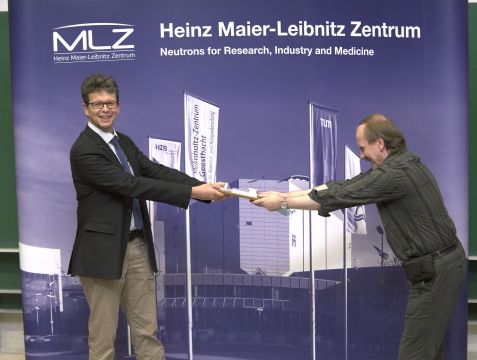
Prof. Dr. Peter Müller-Buschbaum (l) hands over the prize to Prof. retired Dr. Georg Roth while maintaining the safety distance. © W. Schürmann / TUM
The exceptional value of Prof. Roth’s work for MLZ was the separation of the two diffractometer instruments in 2014; POLI the polarized hot neutron diffractometer and HEiDi the single crystal diffractometer. These two instruments had initially shared a beam of hot neutrons. Over the years, the Prof. Roth successfully promoted a total of five joint research projects funded by the Federal Ministry of Education and Research for the purpose of separation and further development of the two instruments. At present, two research projects initiated by Prof. Roth and funded by the German Research Foundation are still ongoing at POLI and HEiDi. In addition, Prof. Roth was a member of the review panels evaluating beamtime proposals for the FRM-II and a lecturer at the Lab Course of the Jülich Centre for Neutron Science, which introduces students to research with neutrons in Garching and Jülich every year. From 2011 to 2014, he was a member of the committee KFN for Research with Neutrons in Germany.
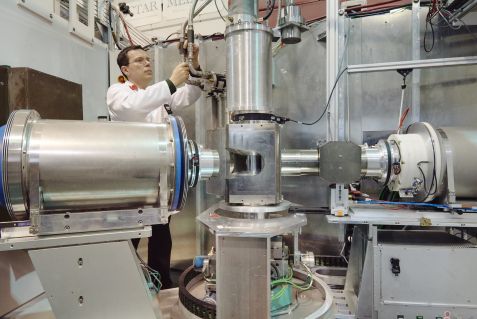
The instrument POLI, with instrument scientist Dr. Vladimir Hutanu, was significantly helped by Prof. Roth to develop its own neutron beam. © W. Schürmann / TUM
Prof. Roth expressed his sincere thanks to Prof. Müller-Buschbaum for the prize, which fits well into his collection of 3D models of the POLI and HEiDi instruments, which he received from his colleagues as a farewell gift. He thanked his five employees at the MLZ, the “core team”, as well as the many post-docs and doctoral students “who did all the work”. In his acceptance speech, Prof. Roth also reminisced about his predecessor Prof. Dr. Gernot Heger, who had built up the diffractometer HEiDi.
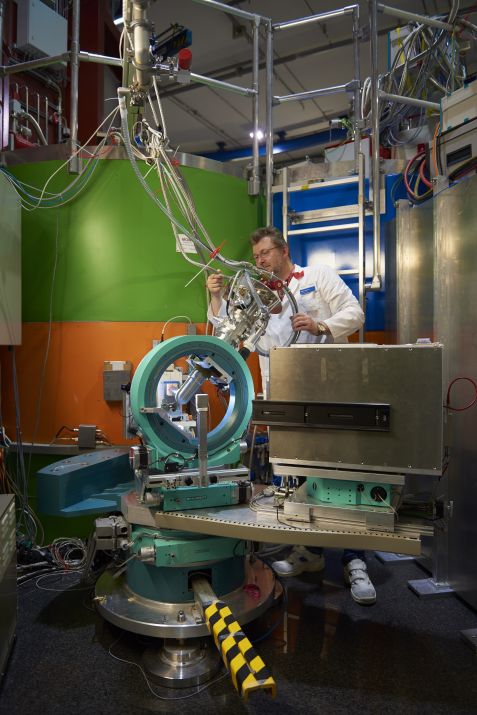
Prof. Dr. Georg Roth also supervised the HEiDi instrument, here with instrument scientist Dr. Martin Meven. © W. Schürmann / TUM
After studying mineralogy and completing his doctorate at the Westfälische Wilhelms-Universität Münster, Prof. Roth joined the Department of Materials Science at Stanford University in the USA as a post-doc. From 1986 to 1995, he worked as a research assistant at the Institute for Nuclear Solid State Physics at the Karlsruhe Research Center. He habilitated in 1993 at the Philipps University of Marburg.
In 1995, Prof. Roth was appointed to a professorship of Applied Crystallography and Mineralogy at the RWTH Aachen University. In 2009, he took over as managing director of the Institute of Crystallography.
Prof. Roth is the second winner of the MLZ Instrumentation Award. In 2019, Prof. Dr. Götz Eckold from the Georg-August-University of Göttingen received the prize from Prof. Müller Buschbaum.
MLZ is a cooperation between:
 > Technische Universität München
> Technische Universität München > Helmholtz-Zentrum Hereon
> Helmholtz-Zentrum Hereon
 > Forschungszentrum Jülich
> Forschungszentrum Jülich
MLZ is a member of:
 > LENS
> LENS > ERF-AISBL
> ERF-AISBL
MLZ on social media:



